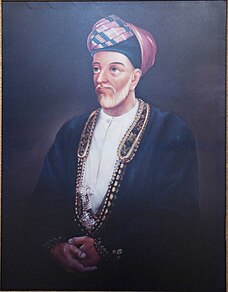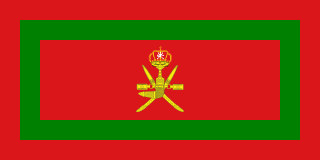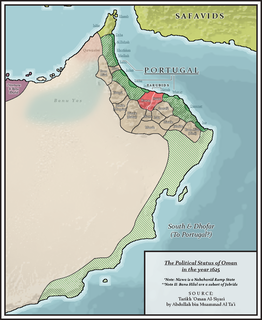Related Research Articles

Oman is the site of pre-historic human habitation, stretching back over 100,000 years. The region was impacted by powerful invaders, including other Arab tribes, Portugal and Britain. Oman once possessed the island of Zanzibar, on the east coast of Africa as a colony. Oman also held Gwadar as a colony for many years.

Sayyid Saïd bin Sultan al-Busaidi, was Sultan of Muscat and Oman, the fifth ruler of the Busaid dynasty from 1804 to 4 June 1856. His rule commenced following the death of his father, Sultan bin Ahmad, in November 1804 and a period of conflict and internecine rivalry of succession that followed. He is often referred to as the Lion of Oman, as one of the greatest Omani sultans. Said's uncle Qais bin Ahmad finally agreed to Said's primacy following Said's killing of his cousin, Badar bin Saif, a pretender to the throne. He is noted for having moved his capital to Zanzibar, during which time the Omani Empire reached the zenith of its power and wealth.

The House of Busaid, also known as Al Said dynasty, is the current ruling royal house of the Sultanate of Oman, and former ruling royal house of the Omani empire, Sultanate of Muscat and Oman and the Sultanate of Zanzibar. It was founded by Ahmad bin Said al-Busaidi, ruler of Oman and its east African territories at the time.

Al Jalali Fort, or Ash Sharqiya Fort, is a fort in the harbor of Old Muscat, Oman. The fort was built by the Portuguese under Philip I of Portugal in the 1580s on an earlier Omani fortress to protect the harbor after Muscat had twice been sacked by Ottoman forces. It fell to Omani forces in 1650. During the civil wars between 1718 and 1747, the fort was twice captured by Persians who had been invited to assist one of the rival Imams. The fort was extensively rebuilt later.
Badr or Badar bin Saif was a member of the Al Said dynasty of Oman. In 1804 he became regent while the heirs to the sultanate were minors. When he attempted to increase his power in 1806 he was killed.

The Omani Empire was a maritime empire, vying with Portugal and Britain for trade and influence in the Persian Gulf and Indian Ocean. At its peak in the 19th century, Omani influence or control extended across the Strait of Hormuz to modern-day Iran and Pakistan, and as far south as Cape Delgado. After the death of Said bin Sultan in 1856 the empire was divided between his sons into two sultanates, an African section ruled by Majid bin Said and an Asian section ruled by Thuwaini bin Said.

The Yarubid dynasty were rulers of Oman between 1624 and 1742, holding the title of Imam. They expelled the Portuguese from coastal strongholds in Muscat and united the country. They improved agriculture, expanded trade and built up Oman into a major maritime power. Their forces expelled the Portuguese from East Africa north of Mozambique and established long-lasting settlements on Zanzibar, Mombasa and other parts of the coast. The dynasty lost power during a succession struggle that started in 1712 and fell after a prolonged period of civil war.
Sultan bin Saif bin Malik was the second of the Yaruba dynasty of Imams of Oman, a member of the Ibadi sect. He ruled from 1649 to 1679. He completed the work of his predecessor, Nasir bin Murshid, in driving the Portuguese out of Oman. Their last base in Muscat fell to his forces in January 1650. He built up Omani sea power, taking the fight against the Portuguese to their bases in India and East Africa. During his reign the country was peaceful and increasingly prosperous.
Nasir bin Murshid was the founder of the Yaruba dynasty of Imams of Oman, a member of the Ibadi sect. He ruled from 1624 to 1649. He took power during a chaotic period when the former dynasty had collapsed and the interior of the country was lawless, while the Portuguese held the main coastal ports. In a series of campaigns he established his authority over the Omani tribes and expelled the Portuguese from most of their bases.
Saif bin Sultan II was the sixth of the Yaruba dynasty of Imams of Oman, a member of the Ibadi sect. He held the position of Imam four times during a chaotic period of civil war and invasion by Persian forces.
Ahmad bin Said al-Busaidi was the first ruler of Oman of the Al Said dynasty. He came to power during a period when Oman was divided by civil war, and the Persians had occupied large parts of the country. During his long rule as Imam the country prospered and regained its leading position in the Persian Gulf.
Bal'arab bin Himyar was an Omani Imam, a member of Yaruba dynasty. He was elected Imam in 1728, holding power in the interior of Oman while his cousin, Saif bin Sultan II, held power on the coast. In 1737, he renounced his claim after being defeated by Saif's Persian allies. He was again elected Imam in 1743 during another Persian invasion, and again held power in the interior while Ahmad bin Said al-Busaidi was recognized as ruler by the coastal people. He died in battle against Ahmad bin Said in 1749, who shortly after became the undisputed ruler of the country.
Sultan bin Murshid was one of the rival Imams during the civil wars in Oman in the final years of the Yaruba dynasty. He was elected Imam in 1742 in place of Saif bin Sultan II. His predecessor called on the Persians for assistance. In mid-1743 Sultan bin Murshid died while defending the town of Sohar against the Persian force.
Muhammad bin Nasir al-Ghafiri was one of the rival Imams during the civil wars in Oman in the final years of the Yaruba dynasty.
Ya'arab bin Bel'arab was one of the rival Imams during the civil wars in Oman in the final years of the Yaruba dynasty.
Said bin Ahmad was briefly the Imam and Sultan of Oman, the second of the Al Said dynasty, ruling the country between 1783 and 1786.
Hamad bin Said was ruler of Oman, the third of the Al Said dynasty, ruling the country between 1786 and 1792.
Sultan bin Ahmad al Busaidi was the Sultan of Oman, the fourth of the Busaid dynasty dynasty, ruling the country between 1792 and 1804.
Salim bin Sultan was joint Sultan of Oman with his brother Said bin Sultan, ruling between 1804 and 1806.

Bithnah Fort is a traditional double story rock, coral and mudbrick fortification located in the Wadi Ham, near the village of Bithnah in Fujairah, United Arab Emirates. The fort has played a significant role in the history of the Emirates, particularly in the emergence of Fujairah as an independent emirate in the early 20th century. With a controlling position overlooking the Wadi Ham, the fort replaced an Iron Age fortification.
References
Citations
- ↑ Miles 1919, p. 276.
- 1 2 Miles 1919, p. 282-283.
- ↑ Miles 1919, p. 283.
- 1 2 3 Thomas 2011, p. 224.
- 1 2 Miles 1919, p. 304.
- 1 2 Miles 1919, p. 305.
Sources
- Miles, Samuel Barrett (1919). The Countries and Tribes of the Persian Gulf. Garnet Pub. ISBN 978-1-873938-56-0 . Retrieved 20 November 2013.
- Thomas, Gavin (2011-11-01). The Rough Guide to Oman. Penguin. ISBN 978-1-4053-8935-8 . Retrieved 2013-11-11.